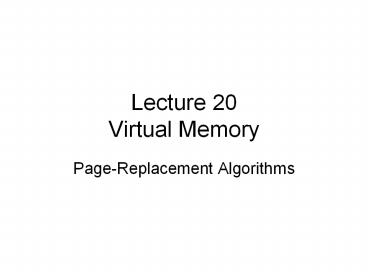Lecture 20 Virtual Memory - PowerPoint PPT Presentation
1 / 14
Title: Lecture 20 Virtual Memory
1
Lecture 20Virtual Memory
- Page-Replacement Algorithms
2
Optimal Policy
- Replace page that will not be used for longest
period of time. - How do you know this?
- Is impossible!, the OS does not know future
events - Why do we present it?
- Used for measuring how well your algorithm
performs.
3
Optimal Policy
4
First-in, First Out(FIFO)
- FIFO policy treats the page frames allocated to a
process as a circular buffer, and pages are
removed in round-robin style. - A page fetched into memory a long time ago may
have now fallen out of use - It requires a pointer that circles through the
page frames of the process - It is simple but not optimal.
5
First-in, First Out(FIFO)
6
Least Recently Used(LRU)
- Replaces the page in memory that has not been
referenced for the longest time. - By the principle of locality, this should be the
page least likely to be referenced in the near
future. - LRU policy does nearly as well as the optimal
policy - Problem Difficulty in implementation
7
Least Recently Used(LRU)
- Counter implementation
- Every page entry has a counter every time page
is referenced through this entry, copy the clock
into the counter. - When a page needs to be changed, look at the
counters to determine which are to change. - Problem Tremendous overhead (even if the
hardware would support this scheme)
8
Least Recently Used(LRU)
- Stack implementation keep a stack of page
numbers in a double link form - Page referenced
- move it to the top
- requires 6 pointers to be changed (entries must
be moved even from the middle of the stack) - No search for replacement
9
Least Recently Used(LRU)
10
LRU Approximation AlgorithmsOne bit Hardware
support
- Initially, all bits are cleared (to 0) by the OS
- As a user process executes, the bit associated
with each page referenced is set (to 1) by the
hardware - After some time, we can determine which pages
have been used and which have not been used by
examining the reference bits
11
LRU Approximation AlgorithmsAdditional-Reference-
bits Hardware support
- We can gain additional ordering information by
recording the reference bits at regular intervals - We can keep an 8-bit byte for each page in a
table in memory - At regular intervals a timer interrupt transfers
control to the OS - The OS shifts the reference bit for each page
into the high-order bit of its 8-bit byte,
shifting the other bits right 1 bit, discarding
the low-order bit - The page with the lowest number is the LRU page
- Notice that the numbers are not guaranteed to be
unique
12
LRU Approximation AlgorithmsSecond-Chance
Algorithm
- Is a FIFO replacement algorithm
- When a page is first loaded in memory, the use
bit is set to 0 - When the page is referenced, the use bit is set
to 1 - When a page is selected
- If its reference bit 0 then we replace this
page - If its reference bit 1 then move to to select
the next FIFO page - Thus, a page that is given a second chance will
not replaced until all the other pages are
replaced (or given second chances)
13
Clock Policy
State of buffer just prior to a page replacement
14
Clock Policy































